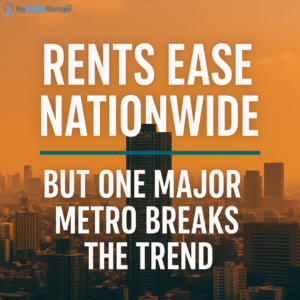For many renters across the United States, there’s finally some welcome news: after years of rapid increases, rental prices are showing signs of cooling down. According to recent data, February marked the nineteenth consecutive month of year-over-year rent declines. However, while most major markets are experiencing this much-needed relief, some cities are still seeing upward pressure—most notably, New York City.
National Rent Trends: A Gradual Decline
Across the 50 largest metro areas in the U.S., the median asking rent fell to $1,691 in February, representing a $15 decrease compared to the same month last year. Although rents are trending downward, it’s important to note that they remain about 14% higher than pre-pandemic levels. This lingering gap highlights how significant the rent surges were during the pandemic years, and how much ground renters still need to regain for affordability to truly return to normal.
A Word of Caution: Potential Future Supply Constraints
One factor contributing to the current cooling is a slowdown in new multifamily construction. In 2024, only 293,931 multifamily permits were issued nationwide—the lowest total since 2017. While this has helped balance oversupply in some areas and ease rent hikes temporarily, it could create challenges down the road if demand continues to outpace future supply, potentially driving prices back up again.
New York City: The Big Exception
While most of the country enjoys falling rents, New York City remains an outlier. In February, NYC’s median rent soared to $2,977, a staggering 7% increase compared to last year and more than $1,000 above the national median.
One of the driving forces behind NYC’s rent surge is its own construction slowdown. In 2024, the city saw a 9.5% decline in multifamily permits, issuing only 42,230 permits for new units. This tightening supply, coupled with sustained demand, is keeping upward pressure on prices, making New York one of the most expensive—and competitive—rental markets in the country.
Top Markets Seeing the Fastest Rent Declines
While New York struggles with rising prices, several other metros are seeing significant rent drops, offering some much-needed relief to renters:
| Metro Area | Annual Rent Decline | Median Rent |
|---|---|---|
| Denver, CO | -6.4% | $1,773 |
| San Diego, CA | -6% | $2,667 |
| Birmingham, AL | -5.4% | $1,165 |
| Austin, TX | -4.8% | $1,462 |
| Riverside, CA | -4.4% | $2,256 |
| Raleigh, NC | -4.2% | $1,571 |
| Cincinnati, OH | -4.2% | $1,220 |
| San Francisco, CA | -4% | $2,790 |
| Phoenix, AZ | -3.9% | $1,597 |
| Cleveland, OH | -3.7% | $1,106 |
These drops often reflect increased multifamily development during the boom years post-pandemic, resulting in greater supply and more competition among landlords today.
Size Matters: Studios vs. Two-Bedroom Apartments
The type of unit also plays a role in rental trends:
-
Studios have seen a more modest increase of 9.7% over the past five years, as solo renters remain price-conscious.
-
Two-bedroom units, on the other hand, have jumped 18.3% in the same period. This suggests that many renters are still choosing to live with roommates or share space to manage rising housing costs.
Spotlight: Colorado Springs – Stability Amid Shifting Markets
One market that stands out for its relative stability is Colorado Springs:
-
Rents rose by a mild 0.9% year-over-year—far less dramatic than either national increases or major city declines.
-
As of February, the average rent in Colorado Springs stood at $1,775, compared to:
-
National average: $1,980
-
Denver: $1,925
-
With its steady pricing and more manageable cost of living, Colorado Springs continues to be an attractive option for renters seeking affordability without sacrificing amenities.
Key Takeaways for Renters & Investors
- Good News for Renters: Most U.S. renters are finally seeing relief from years of escalating prices.
- Watch NYC: New York remains uniquely expensive, as supply shortages persist.
- Future Supply Concerns: Lower construction activity today may reignite price pressures in the years ahead.
- Regional Differences Matter: Some markets are cooling dramatically, while others—like Colorado Springs—offer stable alternatives.
Conclusion
The U.S. rental market is entering a period of much-needed cooling, but that relief isn’t being felt equally across the country. While many renters are benefiting from lower prices and increased supply, others—especially in cities like New York—are still facing ongoing affordability challenges. Moving forward, rental trends will likely continue to be shaped by both regional supply dynamics and national economic factors.
Source:Rents Continue To Cool Across Most of the U.S.—Unless You Live in This City, Nicole Strom Realtor

